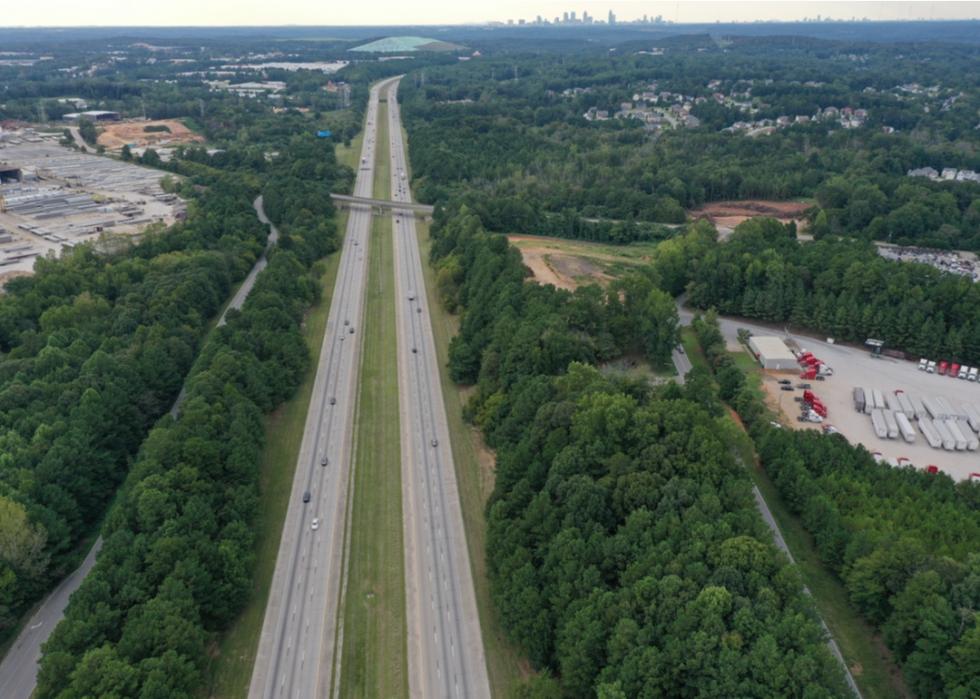
Top 10 US counties with the worst air pollution
This story originally appeared on FindCare and was produced and distributed in partnership with Stacker Studio.
Top 10 US counties with the worst air pollution
Air pollution arguably started when humans first learned how to harness the power of fire, and it became the modern curse of industry, automobiles, and power plants.
Today, in the time of COVID-19, dirty air is even more dangerous to our health. Not only has the pandemic caused the deaths of hundreds of thousands of people in the United States alone, but, according to the National Institute of Environmental Health Sciences (NIEHS), many of the pre-existing conditions that put some segments of the population at greater risk of serious complications from COVID may be linked to long-term exposure to air pollution.
Is there a connection between air pollution and severity of COVID-19?
A study by scientists at Harvard University looked at whether long-term average exposure to fine particulate matter (PM2.5) was associated with a higher risk of dying from COVID-19 in the United States.
By comparing PM2.5 data to the Johns Hopkins University count of COVID-19 deaths in more than 3,000 counties in the spring of 2020, they found long-term average exposure to this type of pollution was associated with worse outcomes from COVID-19.
Air pollution levels by county in the U.S. 2000–2016
Using air pollution data from 2000–2016, FindCare created this map of air pollution by county in the United States.

What is particulate matter?
Particulate matter, or particle pollution, is composed of particles mixed with liquid droplets in the air that can be inhaled and that may be detrimental to your health.
Some particles like soot are large, while others, like those 2.5 micrometers or smaller, are not visible to the naked eye. Most originate in pollutants created by cars, industry, and power plants.
Air pollution may be deadly
The findings of the Harvard Study were significant and alarming. They found an association between long-term exposure to PM2.5 air pollution and death from COVID-19.
The United States adopted the Air Pollution Control Act of 1955, the first federal clean air legislation, several years after 20 people died and more than 7,000 others became sick due to extreme air pollution over Donora, Pennsylvania, in 1948.
The Clean Air Act of 1990 in particular regulated the emission of pollutants from industry and motor vehicles. Nevertheless, experts and scientists have worried that over time, low-level exposure to air pollutants could endanger public health—concerns now underscored by the devastation of COVID-19.
For more information, review this chart to see the top 20 worst cities for air quality.
FindCare ranked the top 10 counties according to their average PM2.5 pollution from 2000 to 2016. They also mapped out the average PM2.5 pollution for all available counties. Here are the results.

#10. Clayton County, Georgia
- Average fine particulate matter pollution, 2000-2016: 13.7 μg/m^3
--- 14.2% above EPA standard
- Worst year: 2000 (18.5 μg/m^3 annual average)
- Best year: 2013 (9.4 μg/m^3 annual average)
A 2018 study by the American Lung Association, using data from the U.S. Environmental Protection Agency, found disturbing levels of particle pollution as recently as 2005, but have also found improvements since then in Clayton County, Georgia.
Located south of Atlanta, Clayton County is home to Hartsfield–Jackson Atlanta International Airport, the world’s busiest airport, and Interstate 75, which carries traffic to and from Atlanta and the surrounding metropolitan area.

#9. Jefferson County, Alabama
- Average fine particulate matter pollution, 2000-2016: 13.8 μg/m^3
--- 14.6% above EPA standard
- Worst year: 2000 (19.0 μg/m^3 annual average)
- Best year: 2015 (9.7 μg/m^3 annual average)
Once a center of iron, coal, and limestone mining, Jefferson County is the most populous in Alabama. Census data shows that an estimated 16.3% of people live below the federal poverty level in the county, which comprises the Birmingham metropolitan area.
Research has repeatedly linked poverty and homelessness with pollution in various ways. According to a 2017 report from The Lancet Commission on pollution and health, almost 92% of pollution-related deaths worldwide happen in low- and middle-income communities. Regardless of economics, pollution-related disease primarily affects minority and marginalized people.

#8. Hamilton County, Ohio
- Average fine particulate matter pollution, 2000-2016: 13.8 μg/m^3
--- 14.9% above EPA standard
- Worst year: 2005 (17.4 μg/m^3 annual average)
- Best year: 2016 (10.1 μg/m^3 annual average)
Hamilton County in southernmost Ohio includes metropolitan Cincinnati and lies across the Ohio River from Kentucky. It’s home to several Fortune 500 companies and their manufacturing factories, including grocery giant Kroger and consumer products conglomerate Procter & Gamble.
In 1906, the Smoke Abatement League was established by the Cincinnati Women’s Club to fight smoke and air pollution in Cincinnati. They created the Office of the Chief Smoke Inspector, one of the first agencies to help enforce community smoke regulations. Today, it’s part of the Southwest Ohio Air Quality Agency, which monitors air pollution and provides real-time air quality data to the public.

#7. Vanderburgh County, Indiana
- Average fine particulate matter pollution, 2000-2016: 13.8 μg/m^3
--- 15.2% above EPA standard
- Worst year: 2000 (18.0 μg/m^3 annual average)
- Best year: 2016 (10.2 μg/m^3 annual average)
Southwestern Indiana’s Vanderburgh County is home to the city of Evansville, which has historically been surrounded by a heavy concentration of coal-fired power plants. The area has been a target of the Sierra Club’s Beyond Coal Campaign promoting renewable energy.

#6. Fulton County, Georgia
- Average fine particulate matter pollution, 2000-2016: 13.8 μg/m^3
--- 15.2% above EPA standard
- Worst year: 2000 (18.9 μg/m^3 annual average)
- Best year: 2013 (9.3 μg/m^3 annual average)
Fulton County got a failing grade in a 2019 assessment of its ozone levels by the American Lung Association, using federal environmental data. Ground-level ozone forms when pollutants emitted by vehicles, power plants, and other sources react in sunlight, according to the EPA.
Heavily trafficked Interstates 20, 75, and 85 all converge in Atlanta—at the heart of Fulton County in what is called the Downtown Connector.

#5. Marion County, Indiana
- Average fine particulate matter pollution, 2000-2016: 14.3 μg/m^3
--- 19.3% above EPA standard
- Worst year: 2005 (17.9 μg/m^3 annual average)
- Best year: 2016 (10.4 μg/m^3 annual average)
Marion is Indiana’s largest county, and it is where Indianapolis is located. Enforcement of air quality standards in Indiana is highly dependent on federal standards. Under Indiana law, state environmental rules cannot be more stringent than those set by the federal government.

#4. Tulare County, California
- Average fine particulate matter pollution, 2000-2016: 14.5 μg/m^3
--- 20.8% above EPA standard
- Worst year: 2002 (18.7 μg/m^3 annual average)
- Best year: 2010 (11.9 μg/m^3 annual average)
Situated between Bakersfield and Fresno, Tulare County’s top commodity is milk, producing more than any other county in the nation. Famously home to more cows than humans, livestock is a huge contributor to methane emissions, which negatively impacts the climate and human health.
In 2019, conservation groups came to an agreement with the county that would help lower pollution from industrial dairies through the generation of renewable energy among other efforts.

#3. Fresno County, California
- Average fine particulate matter pollution, 2000-2016: 15.5 μg/m^3
--- 29.2% above EPA standard
- Worst year: 2000 (19.4 μg/m^3 annual average)
- Best year: 2016 (12.2 μg/m^3 annual average)
Findings by the American Lung Association, based on Environmental Protection Agency data, give Fresno failing grades for its ozone level, 24-hour particle pollution, and annual particle pollution level.
The EPA has launched efforts in the region, at the heart of the heavily agricultural San Joaquin Valley, to promote clean farming technology such as electric tractors and hybrid and zero-emission vehicles for dairies and farms, solar-powered composting and irrigation pumps to replace those powered by diesel and cleaner alternatives for disposing of the paper trays used to dry hand-harvested raisin grapes that are traditionally burned after use.

#2. Los Angeles County, California
- Average fine particulate matter pollution, 2000-2016: 15.7 μg/m^3
--- 31.0% above EPA standard
- Worst year: 2001 (21.6 μg/m^3 annual average)
- Best year: 2015 (12.2 μg/m^3 annual average)
Air quality in Southern California has gotten vastly better not only in recent decades, but it has undergone dramatic improvements since the 1950s when Los Angeles was notorious for smog so thick that it could limit visibility to a few city blocks.
Fueling the dirty air was a lack of public transportation, long commutes, an extensive freeway system, and a booming economy.

#1. Orange County, California
- Average fine particulate matter pollution, 2000-2016: 15.8 μg/m^3
--- 31.6% above EPA standard
- Worst year: 2001 (22.0 μg/m^3 annual average)
- Best year: 2015 (12.5 μg/m^3 annual average)
Nearly 3.2 million people live in Orange County, where, in 2006, 70% of voters approved a 30-year half-cent sales tax to help reduce transportation-related air pollution through less freeway congestion and expanded public transit.
In a link between air quality and COVID-19, in late January, local officials suspended limits on Orange County crematoriums, which are typically subject to regulations on the number of human remains incinerated due to potential impacts on air quality. The limits were lifted due to the substantial increase in the number of deaths due to COVID-19.
Continue reading to see the air pollution rankings of 50 counties in the U.S. and search for others.



